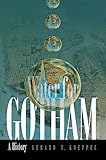Water for Gotham : A History / Gerard T. Koeppel.
Material type: TextPublisher: Princeton, NJ : Princeton University Press, [2022]Copyright date: ©2001Description: 1 online resource (376 p.) : 50 halftonesContent type:
TextPublisher: Princeton, NJ : Princeton University Press, [2022]Copyright date: ©2001Description: 1 online resource (376 p.) : 50 halftonesContent type: - 9780691237848
- HISTORY / United States / 19th Century
- Above Par
- Abutment
- Alley
- Appraiser
- Atlantic Ocean
- Banana
- Biogeography
- Biography
- Biologist
- Bourgeoisie
- Brine pool
- Business class
- Caleb (Buffy the Vampire Slayer)
- Cast iron pipe
- Catskill Mountains
- Chairman
- Charles Darwin
- Chief engineer
- Cholera
- Christopher Colles
- Coenties Slip
- Coffeehouse
- Commissioner
- Constitutionality
- Croton Aqueduct
- Croton River
- Culvert
- Customer
- Deep sea
- Designer
- Drinking water
- Dutch West India Company
- East Pacific Rise
- Edmund Andros
- Elizabeth Gaskell
- Engineering
- Erie Canal
- Everyman's Library
- Evolution
- Fauna
- Fresh water
- Gastropoda
- Groundwater
- Guaymas
- Harlem River
- Household
- Hudson River
- Hydrocarbon
- Hydrothermal vent
- Indication (medicine)
- Industrialisation
- John Barker Church
- Labor unrest
- Laborer
- Latin America
- Lava
- Legislature
- Logging
- Lydia Maria Child
- Maritime nation
- Martin Van Buren
- Masonry
- Michael Joseph (publisher)
- Mid-Atlantic Ridge
- Misconduct
- Mussel
- New York Harbor
- Nuisance
- Oil spill
- Park Theatre (London)
- Parliamentary sovereignty
- Passenger pigeon
- Patrick Carr
- Per capita
- Percentage
- Peter Stuyvesant
- Philip Hone
- Politics
- Polychaete
- Residence
- Rift valley
- Samuel Osgood
- Saw Mill River
- Seawater
- Sediment
- Sparkling wine
- Steam engine
- Steam locomotive
- Steamship
- Sulfide
- Tariff
- Tax
- Teapot
- The Bronx
- The Manhattan Company
- United States Senate
- Vegetable
- Water supply
- Whigs (British political party)
- William L. Clements Library
- online - DeGruyter
| Item type | Current library | Call number | URL | Status | Notes | Barcode | |
|---|---|---|---|---|---|---|---|
 eBook
eBook
|
Biblioteca "Angelicum" Pont. Univ. S.Tommaso d'Aquino Nuvola online | online - DeGruyter (Browse shelf(Opens below)) | Online access | Not for loan (Accesso limitato) | Accesso per gli utenti autorizzati / Access for authorized users | (dgr)9780691237848 |
Frontmatter -- Contents -- Illustrations -- Preface -- Acknowledgments -- ONE "Give Us Cold Water" -- TWO Manahata Goes Dutch -- THREE English Well-Being -- FOUR Tea Water and the Works That Weren't -- FIVE New City, Old Trouble -- six Aaron's Water -- SEVEN Fools of Gotham -- EIGHT Catching the Croton Bug -- NINE The Work Begins -- TEN Taking the High Road? -- ELEVEN Filling the "Big Teapot" -- EPILOGUE New York's Water from Then to Now -- Notes -- Index
restricted access online access with authorization star
http://purl.org/coar/access_right/c_16ec
Water for Gotham tells the spirited story of New York's evolution as a great city by examining its struggle for that vital and basic element--clean water. Drawing on primary sources, personal narratives, and anecdotes, Gerard Koeppel demonstrates how quickly the shallow wells of Dutch New Amsterdam were overwhelmed, leaving the English and American city beleaguered by filth, epidemics, and fires. This situation changed only when an outside water source was finally secured in 1842--the Croton Aqueduct, a model for urban water supplies in the United States. As the fertile wilderness enjoyed by the first Europeans in Manhattan vanishes and the magnitude of New York's water problem grows, the reader is introduced to the plans of Christopher Colles, builder of the first American steam engine, and of Joseph Browne, the first to call for a mainland water source for this island-city. In this vividly written true-life fable of the "Fools of Gotham," the chief obstacle to the aqueduct is the Manhattan Company. Masterminded by Aaron Burr, with the complicity of Alexander Hamilton and other leading New Yorkers, the company was a ruse, serving as the charter for a bank--today's Chase Manhattan. The cholera epidemic of 1832 and the great fire three years later were instrumental in forcing the city's leaders to finally unite and regain New York's water rights. Koeppel's account of the developments leading up to the Croton Aqueduct reveals it as a triumph not only of inspired technology but of political will. With over forty archival photographs and drawings, Water for Gotham demonstrates the deep interconnections between natural resource management, urban planning, and civic leadership. As New York today retakes its waterfront and boasts famous tap water, this book is a valuable reminder of how much vision and fortitude are required to make a great city function and thrive.
Mode of access: Internet via World Wide Web.
In English.
Description based on online resource; title from PDF title page (publisher's Web site, viewed 29. Jun 2022)


